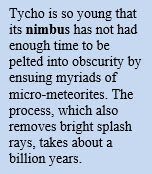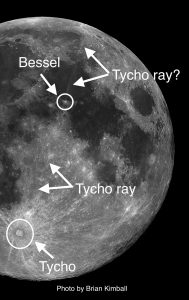 The week of February 18-24 takes us from Day 14 through Day 20. This week we will highlight the crater Tycho, viewable on Monday (essentially full moon) and for most of the week.
The week of February 18-24 takes us from Day 14 through Day 20. This week we will highlight the crater Tycho, viewable on Monday (essentially full moon) and for most of the week.
 Tycho: [SW/P8; L=11°W] On Day 8, we got to see Tycho in its persona as the prototype of complex craters. Now we get to see its other face: it has the most spectacular system of rays on the Moon, and on Day 14 they blossom into their full glory.
Tycho: [SW/P8; L=11°W] On Day 8, we got to see Tycho in its persona as the prototype of complex craters. Now we get to see its other face: it has the most spectacular system of rays on the Moon, and on Day 14 they blossom into their full glory.
As you gaze at the ray system, try to appreciate the force behind an impact that would scatter boulders more than a thousand miles across the surface of the Moon. It is popularly assumed that these rays have the texture of face powder and that an astronaut would have difficulty detecting them if he were standing in the middle. Such is not the case. The brighter rays are made up of ejected rubble that consists of crushed rock and boulders that are up to a couple of feet in diameter. Large rays are commonly several feet thick and would be difficult to walk through.
 With one curious exception, all the rays converge, quite logically, on Tycho, their point of origin. But there is one ray extending from the S.W. portion of Tycho’s nimbus (the dark collar that just encircles the rim) that does not lead us directly back to Tycho; it is actually tangential to it! Copernicus has some similarly curious rays. What ballistic fluke happened in the immediate aftermath of the explosion to have sent the debris on such a bizarre flight path?
With one curious exception, all the rays converge, quite logically, on Tycho, their point of origin. But there is one ray extending from the S.W. portion of Tycho’s nimbus (the dark collar that just encircles the rim) that does not lead us directly back to Tycho; it is actually tangential to it! Copernicus has some similarly curious rays. What ballistic fluke happened in the immediate aftermath of the explosion to have sent the debris on such a bizarre flight path?
 The Tycho ray pattern gives us important information. Notice how the rays are not equally distributed in all directions but fly off toward the northwest, east, and southwest; however, there is a large empty zone toward the west (called “the forbidden zone”). This is where the impactor came from. This butterfly pattern is indicative of a very low-flying object, otherwise the rays would be distributed equally around the impact point, as they are with Copernicus and Kepler (both of which you can see very clearly tonight). The exact same process that created the Tycho rays was duplicated closer to the eastern limb at the craters Proclus [H14] and Stevinus A and Furnerius A [N15], with nearly identical results. And here is a curious thing: the butterfly patterns around these four craters all indicate that the impactors came in from the west. Coincidence?
The Tycho ray pattern gives us important information. Notice how the rays are not equally distributed in all directions but fly off toward the northwest, east, and southwest; however, there is a large empty zone toward the west (called “the forbidden zone”). This is where the impactor came from. This butterfly pattern is indicative of a very low-flying object, otherwise the rays would be distributed equally around the impact point, as they are with Copernicus and Kepler (both of which you can see very clearly tonight). The exact same process that created the Tycho rays was duplicated closer to the eastern limb at the craters Proclus [H14] and Stevinus A and Furnerius A [N15], with nearly identical results. And here is a curious thing: the butterfly patterns around these four craters all indicate that the impactors came in from the west. Coincidence?
There is one jaw-dropping ray that appears to extend from Tycho all the way across Mare Serenitatis and keeps on going. There has been some speculation that this ray has merely been “renewed” by a ray from the crater Bessel [NE/G11] which it crosses. Patrick Moore finds this implausible, and it does seem unlikely that Bessel would produce only one solitary ray of such magnificence.
Tycho has another unusual feature that is brought out by the high Sun: Notice the nimbus, the dark collar that just encircles the rim. No other crater on the Moon has a surrounding nimbus that is so dark.
 At a mere 109 million years, Tycho is the youngest of the large craters on the Moon. Although its northern cousin Copernicus is about 800 million years old, they are both considered “youngsters.” Notice how the rays emanating from Copernicus and Tycho have entirely different characters. Whereas the Tycho rays are clearly delineated, those from Copernicus are wispy, plume-like, and shorter. It is curious that this is so, particularly since Copernicus is the larger crater and was created by a more powerful explosion.
At a mere 109 million years, Tycho is the youngest of the large craters on the Moon. Although its northern cousin Copernicus is about 800 million years old, they are both considered “youngsters.” Notice how the rays emanating from Copernicus and Tycho have entirely different characters. Whereas the Tycho rays are clearly delineated, those from Copernicus are wispy, plume-like, and shorter. It is curious that this is so, particularly since Copernicus is the larger crater and was created by a more powerful explosion.
OF ADDITIONAL INTEREST NEAR THE MOON: COMET
There is a reasonably bright comet in the skies, C/2018 Y. Wait until Thursday evening as soon as it gets very dark (around 7:30) and before a bright Moon rises. It will be half way between Auriga and Gemini.
Because he knew I was interested in the Moon, a friend recently gave me a book with the peculiar title Who Built the Moon by Christopher Knight and Alan Butler. The title itself was a red flag, but because it was a gift, I felt obligated to read it. The book is dedicated to the bizarre proposition that the Moon is entirely an artificial object created by aliens. Not only that, the aliens came back from the future to build it. I slogged through to the bitter end but somehow remained unconvinced. You needn’t put it on your must read list, unless you’re looking for some outlandish amusement.
======================
It is highly recommended that you get a copy of Sky and Telescope’s Field Map of the Moon, the very finest Moon map available for use at the telescope. It is available for $10.95 at www.skyandtelescope.com and on Amazon. All features mentioned in this blog will be keyed to the grid on the Field Map and will look like this: Plato: [NW/D9]
Credits:
Courtesy of Gray Photography of Corpus Christi, Texas
Lunar photos: NASA / USGS / BMDO / LROC / ASU / DLR / LOLA / Moon Globe. Used by permission
- Rupes Cauchy: A Best Known Fault on the Moon - July 22, 2024
- Moon Crater Schickard – Crater Floor has Stripes - July 15, 2024
- Moon Craters Langrenus and Vandelinus - July 8, 2024